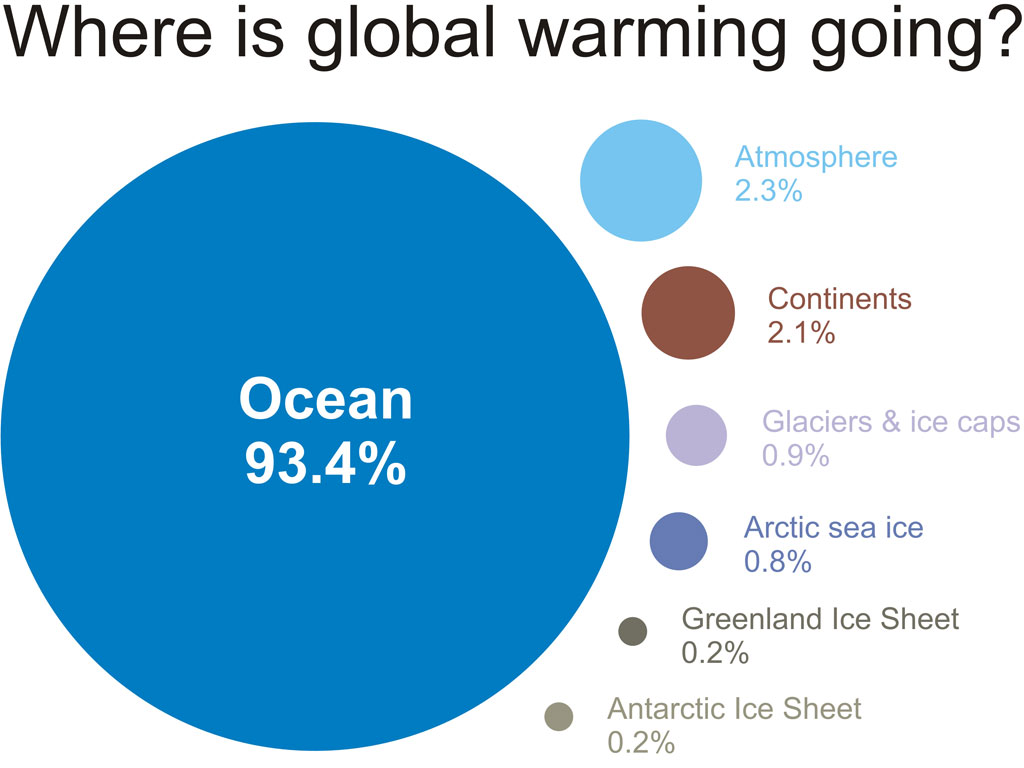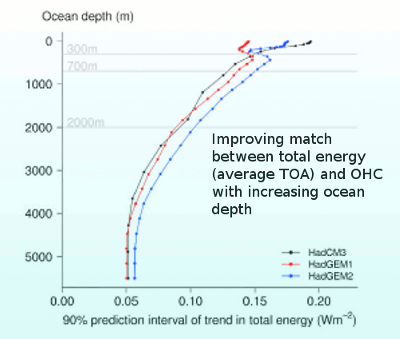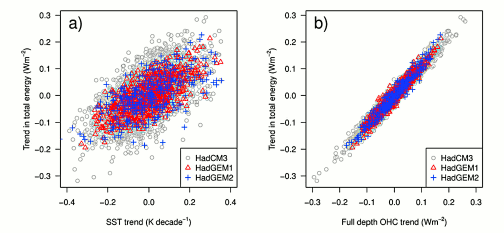
Most of the heat from global warming is going into the oceans. Covering some 70% of the Earth's surface and having a heat capacity a thousand times more than the atmosphere, it's easy to understand why the oceans are the main heat sink.

Multiple studies measuring from the ocean surface down to 700 metres show very little warming, or even cooling, over multiple years in the last decade. This is surprising given that some studies estimate that the imbalance at the-top-of-the-atmosphere (TOA), the difference between energy entering and leaving Earth's atmosphere over that time, has actually grown. So we might have expected the 700 metre sea surface layer to show increased warming. However the average depth of the ocean is around 4300 metres, and in a recent SkS post, we saw that when measurements were extended down to 1500 metres, the oceans were found to still be warming, indicating that heat is somehow finding a way down to the deep ocean.
SkS has recently looked at Asian aerosols as a contributor to the 'slowdown' in warming, but a recent climate modeling study, Palmer (2011), suggests another possible cause - that heat is able to be buried into deeper ocean layers, something the observations seem to support. The study found that there are mechanisms operating in the climate models, over decadal timeframes, which are able to distribute heat to all depths of the ocean. So only measuring down to 700 metres doesn't give an accurate indication of the total amount of heat being absorbed by the oceans.
To examine the relationship between the top-of-the-atmosphere (TOA) and ocean heat, Palmer (2011) used three generations of Hadley Centre climate models and ran multi-century simulations in which the TOA was imbalanced. Three different values for this TOA imbalance arose out the processes inherent in each model - in other words the natural variability in the models.
The authors found that it was necessary to integrate OHC from all ocean layers, to understand what was going on at TOA. See Figure 1.

Figure 1- The 90% prediction interval for decadal trend in total energy (average TOA in the models) associated with OHC from the surface to deeper ocean layers. As deeper layers of the ocean are included in measurements, the average TOA and OHC show closer agreement. See Palmer (2011) for details.
The 3 coloured lines represent the 3 climate models used. The vertical axis is the ocean depth and the horizontal axis represents the ability of the decadal ocean heat content trend to predict the decadal TOA imbalance trend on 9 out of 10 occasions (90%). By including successively deeper layers of the ocean the difference between the value of TOA and OHC grows smaller.
Statistical regression analysis of the results found a weak relationship between sea surface temperature (SST) and TOA in the climate models (Figure 2a), due to internal variability. Only when the full depth OHC trend was included in the analysis was there found to be a strong relationship between OHC and TOA (figure 2b). In other words, to account for the heat sequestered in the ocean, we have to measure right to the bottom.

Figure 2 - Plot of linear decadal trends in total energy regressed against a) decadal trends in globally averaged sea surface temperature; b) decadal trends in full-depth ocean heat content. Note that total energy is equivalent to to the average TOA over the same period. From Palmer 2011.
A common misconception about the oceans seems to be the idea that heat can only travel directly downwards into deeper ocean layers, as if the oceans were only one-dimensional models, or perhaps a bathtub. Clearly this isn't the case, a vast amount of heat is moved around the world's ocean via the Thermohaline Circulation, and science is steadily coming to terms with the many ocean processes which mix heat down into the depths. La Nina is a classic example of how quickly heat from surface layers can be mixed down to the deep, and this is something I'll cover in my next post.
So to sum up:
Related SkS posts: Deep ocean warming solves the sea level puzzle, Billions of Blow Dryers: Some Missing Heat Returns to Haunt Us, Ocean Cooling Corrected, Again, and The Deep Ocean Warms When Global Surface Temperatures Stall
Posted by Rob Painting on Saturday, 24 September, 2011
 |
The Skeptical Science website by Skeptical Science is licensed under a Creative Commons Attribution 3.0 Unported License. |